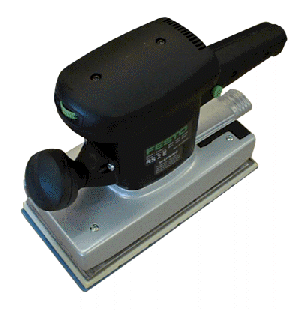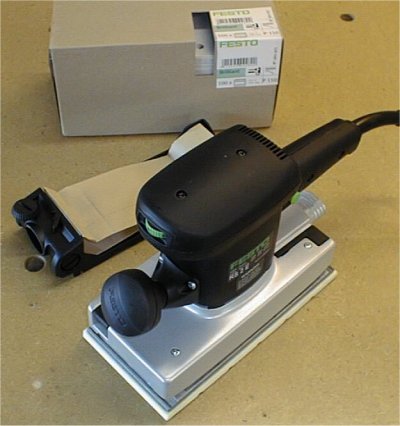|
|
|
| Festool makes several types and
sizes of sanders, this is their half sheet sander. This type of sander was once the
mainstay of cabinet shops. Since the introduction of inexpensive random orbit
sanders they have fallen into decline. That is unfortunate since they serve a
function that is not truly filled by random orbit sanders. Impressions |
 |
| The RS2e is fairly quiet; with the speed
set to maximum it is about as loud as the Festool vacuum, on low speed its noise is
considerably reduced. In evaluating this tool I spent quite a bit of time going back
and forth between it and the 5" Bosch ROS. It really didn't take long to
develop a preference for the Festool machine. This is mostly due to the considerably
higher quality "feel". I never really had any negative associations with the Bosch until I started using this machine. The smooth power delivered by the RS2e just makes the Bosch seem clunky by comparison. I think the reason it makes even a Bosch seem clunky is the better balance, low noise and vibration. It is very easy to control the RS2e even though it is somewhat larger than a standard ROS. In Use I did some specific tests to try and quantify the difference between the RS2e and the ROS in use on solid hard and softwoods and veneer plywood surfaces. In some timed tests I found that both machines take a given surface from a planed to a smooth 220 grit sanded surface in about the same amount of time. When the wood is stained, neither machine leaves swirl mark patterns in the surface to mar the finish. Ultimately, I could find very little difference in the time it took to sand a surface or the smoothness there of. I could tell that the RS2e did perform better going into corners and up to edges which is to be expected of this type of sander. With a ROS it either cannot get into a corner or you have to tilt the pad to get to an edge which can cause marks. |
|
 |
I did find that the RS2e is capable of
sanding flatter, it's not that you'll get a noticeably un-flat surface with a ROS, it's
just that a half sheet sander such as this is designed to be flatter. Where you will
notice this is in woods like pine which have hard and soft growth rings, rotary cut oak
veneer plywood with its wide bands of porous grain patterns, and on finishes. After using the sander for any length of time other Festool qualities comes to light. The long power cord is exactly the right length to be used with the Festool vacuum. There is even a little valve on the dust bag that can be closed so its contents are not disgorged when it is not connected to the sander. The RS2e comes in its own "systainer", a special Festool brand container that can be clipped onto other systainers to form larger more easily moved units. They can also be clipped onto the tops of their vacuums. |
| Festool also has their own line of
sandpaper. It is categorized in several types for different surfaces and comes in a
wide array of grit values. The Festool paper is of high quality and it is cloth
backed. I don't know if anyone else carries this paper but the Festool sandpaper is
not expensive so I just wouldn't bother with anything else. In addition to the hook and loop type, the RS2e will also take half sheets of regular sandpaper. There are two levers in the sanding body that actuate the holders for this. The clamps also have three little spikes to more firmly grip the paper. While you can get loose paper onto the machine with a hook and loop pad fitted you really should use the pad they sell for this purpose; the pad is easily removed. Conclusion The RS2e isn't intended to replace a ROS or belt sander for than matter but I've found that for cabinet work this is the type of machine that will fill the greater percentage of my sanding tasks. If I had to throw away all my sanders (6) except one, this is the one I would keep. |
|